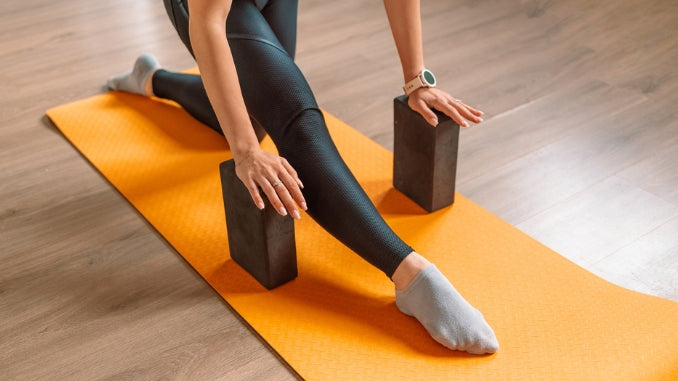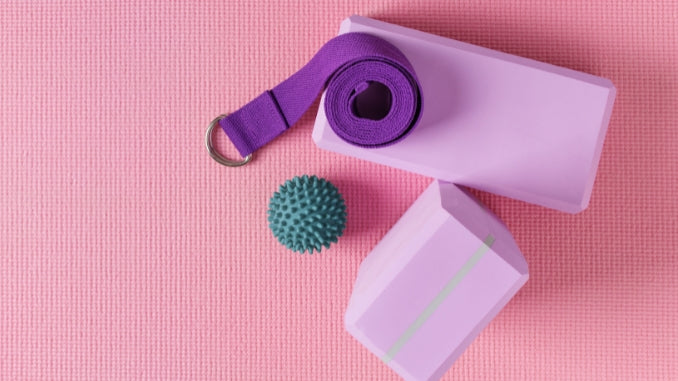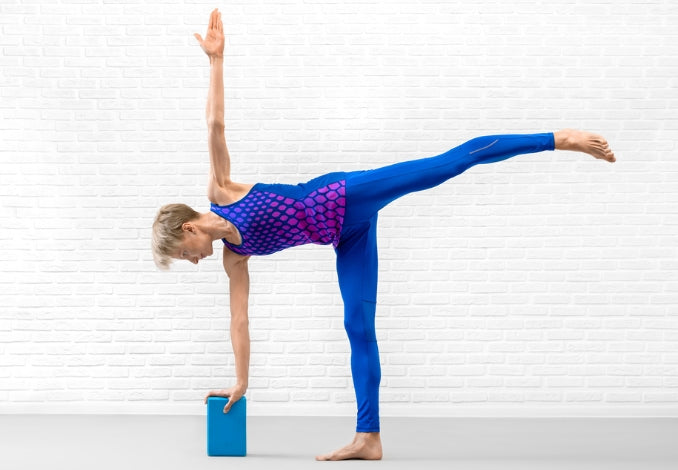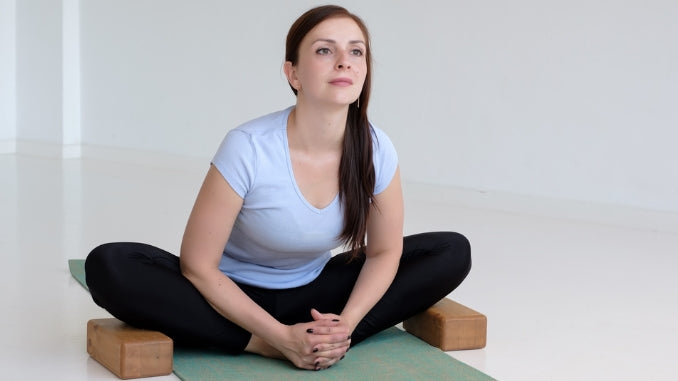
Yoga Blocks: Yoga for Pelvic Floor Strengthening
Medical Disclaimer: The content in this blog is intended solely for educational purposes and, therefore, should not replace advice from a medical professional.
B.K.S. Iyengar introduced yoga blocks, also known as yoga bricks to strengthen pelvic floor muscles.
Yoga blocks, available in various materials, facilitate a range of poses and contribute to mindfulness and concentration in practice. Additionally, this post will explore the diverse benefits of yoga blocks and demonstrate how to integrate them effectively into your yoga journey to deepen your practice and support physical and mental well-being.
Disclaimer: The effectiveness and safety of yoga blocks and practices in this post can vary based on individual health conditions and abilities.
Understanding Yoga Blocks and Bricks

What are Yoga Blocks?
Iyengar recommended that yoga blocks be similar in size to a house brick, measuring approximately 9 inches by 4.5 inches by 3 inches. This size has become the standard for yoga blocks today.
Yoga blocks are solid blocks of foam or cork designed to provide support and stability in yoga poses. These props benefit practitioners of all levels, promoting better postures, deeper stretches, and increased confidence.
The yoga brick is another yoga prop that looks like a yoga block you might be interested in. Moreover, here are the definite explanations of their difference to avoid confusing this with a yoga block.
What is the Distinction Between a Yoga Block and Yoga Brick?
Blocks are typically larger, aiding in extension poses, while bricks are smaller, helping in various poses.
1. Size
Yoga blocks are typically larger and flatter than yoga bricks. They measure approximately 9 inches long, 4.5 inches wide, and 3 inches thick. This size makes them ideal for supporting poses requiring a lot of extension, such as forward folds and backbends.
Yoga bricks, on the other hand, are smaller and more compact. They measure approximately 3 inches long, 3 inches wide, and 6 inches thick. This makes them more versatile for various poses, such as standing, seated, and inversions.
2. Material
Foam blocks are the most common and are lightweight and portable. Cork blocks are more dense and provide more support. Wood blocks are the least common and are the most durable.
Foam bricks are lighter and less expensive, while cork bricks are more durable and provide more support.
3. Use
Practitioners often use yoga blocks to support the hands, feet, or hips in poses requiring extension. They can also elevate the hips in poses requiring a lot of flexibility, such as hamstring stretches.
Yogis use yoga bricks to support seated poses like Easy Pose and Lotus Pose. Moreover, they can also help balance standing poses like Tree Pose and Warrior II Pose.
The figure below shows the difference between a yoga block and a brick.
| Feature | Yoga Block | Yoga Brick |
| Size | 9 inches long, 4.5 inches wide, 3 inches thick | 3 inches long, 3 inches wide, 6 inches thick |
| Material | Foam, Cork, Wood | Foam, Cork |
| Use | Forward Folds, Backbends | Standing poses, seated poses, inversions |
Types and Sizes of Yoga Blocks
3 Types of Blocks
Yoga blocks are vital props for yogis of all levels. They can provide support and stability, modify poses, and also deepen practice. Each type has its own unique benefits.
1. Foam
Foam yoga blocks have become the most popular type of yoga block. Additionally, they are lightweight, inexpensive, and comfortable. Foam blocks are also very gentle on the body, making them a good choice for beginners or people with injuries.
|
Pros:
Cons:
|
Remarks: Foam yoga blocks are also preferred by individuals looking for a combination of affordability, comfort, and lightweight design. They are particularly suited for beginners or individuals with physical limitations. Moreover, they stand out in user-friendliness and cost-effectiveness, but you must consider their reduced durability and stability for your yoga practice needs.
1. Hughes: "I use these durable blocks every day for all my stretching and yoga routines. Additionally, they hold up perfectly under my full body weight, even with extra weights added. In short, they've been a fantastic addition to my workout gear."
2. Howard: "Originally, I purchased these blocks for my wife after she misplaced hers. Surprisingly, I've found they're great for elevating my feet during toilet use, improving alignment, and easing bowel movements."
2. Cork
Cork yoga blocks are a more eco-friendly option than foam blocks. Additionally, they are also heavier and more stable, making them a good choice for people who want a long-lasting block.
|
Pros:
Cons:
|
Remarks: Environmentally conscious practitioners who value stability and durability choose cork yoga blocks as their ideal tool. Moreover, these blocks offer eco-friendly composition and robust support for those searching for a reliable and sustainable yoga practice tool, even though they are slightly heavier and more expensive than foam blocks.
1. Philips: "As a yoga instructor, I've relied on foam blocks for a long time but recently upgraded to a cork set after thorough research. Moreover, these cork blocks, ranked in the top three for affordability, have significantly enhanced my teaching and practice. While I never endorse products to my students, I let them try my cork blocks, and many have since bought their own. Moreover, despite being heavier, they offer superior stability for balance poses and are a worthwhile addition to any yoga routine."
2. Beth: "Foam blocks were my go-to, but they lacked the necessary support. After some research, I switched to these cork blocks, which are both sturdy and reasonably priced. Moreover, they surpassed my expectations, and while not as lightweight as foam, they're perfect for my home practice. Additionally, their width is particularly beneficial for my hands, which are starting to show signs of arthritis. I'm delighted with their performance and consider them an excellent investment."
3. Wood
Wood yoga blocks are the most durable and heaviest type. Additionally, they are a good choice for people who want a stable and supportive block.
|
Pros:
Cons:
|
Remarks: Yogis who value durability and stability opt for wood yoga blocks, the premium choice for a solid, long-lasting practice aid. Additionally, these blocks provide unmatched support and aesthetic appeal, though their weight and hardness may not suit everyone. This highlights the importance of aligning your block choice with personal comfort and practice requirements.
1. Lawrence: "I'm impressed with the quality of the wood and the comfortable shape of these blocks. Additionally, the non-slip bottom is a good feature, ensuring stability during use. With proper care to avoid dragging, the skid-resistant bottom remains intact and effective. They've been a reliable part of my practice for the past two months."
2. Katie: "The grippy bottom is a standout feature for me, especially on the slick floors at my circus school. Moreover, as someone who is larger, I appreciate the block's size and slightly taller height, which I've quickly adapted to without any issues."
Sizes of Yoga Blocks
- Standard yoga blocks - The most common size of yoga blocks. Additionally, they are 9 inches long, 6 inches wide, and 3 inches tall. Standard yoga blocks are a good choice for most people.
- Half-size yoga blocks - A one-half yoga block typically measures 12 inches x 8 inches x 1 inch. However, sizes can differ depending on the manufacturer. For example, some half-yoga blocks may be slightly thinner or thicker than 1 inch.
- Extra-thick yoga blocks - Extra-thick yoga blocks measure 9" in length, 6" in width, and 4" in height. Moreover, they are also a good choice for people who need more support or want to deepen their practice.
How to Choose the Right Yoga Block Size
- Consider the material and size based on your practice needs and personal preferences.
- Experiment with different types to find the one that suits you best.
For example, if you are a beginner, choose a lightweight, comfortable foam block. Moreover, if you have injuries, choose a cork block that is gentle on the body. And if you want a block that will last a long time, choose a durable wood block.
Here is a table that summarizes the different types of yoga blocks:
| Type | Material | Size | Benefits |
| Foam | EVA Foam | 9" x 6" x 3" | lightweight, inexpensive, comfortable |
| Cork | Cork | 9" x 6" x 3" | eco-friendly, heavy, stable |
| Wood | Maple, Pine, Britch | 9" x 6" x 3" | durable, heavy, stable |
Pelvic Floor Yoga Poses That Use Blocks
The pelvic floor is essential for supporting organs and controlling various bodily functions. Additionally, deterioration of these muscles can lead to issues like pelvic pain and urinary incontinence.
Pelvic floor yoga is a recommended gentle method to fortify these muscles and improve overall pelvic health. Participants in a study were encouraged [¹] to practice yoga at home using a provided block, highlighting the importance of consistent practice and using props to aid in the exercises.
Standing Poses
1. Triangle Pose (Trikonasana)

Place a block next to your front foot to bring the floor closer to you and allow you to reach the ground comfortably.
2. Half-Moon Pose (Ardha Chandrasana)

For balance, place a block in front of your supporting leg, allowing you to reach deeper into the side stretch.
3. Chair Pose (Utkatasana)

Place a yoga block or brick between your thighs to keep the knees in line, preventing them from turning outwards and thus maintaining the pose's integrity. Additionally, the chair pose is particularly effective for engaging and strengthening the pelvic muscles among the various yoga poses.
4. Warrior II Pose (Virabhadrasana II)
Place a yoga block behind your back foot to support your hip and maintain a deeper lunge.
Seated poses
1. Pigeon Pose (Eka Pada Rajakapotasana)
Place a block or blocks under your sitting bones to elevate your hips and reduce strain on your hamstrings.
2. Hero Pose (Virasana)
Place a block under your seat to lift your hips and reduce pressure on your knees.
3. Bound Angle Pose (Baddha Konasana)
Place blocks under your knees to support your legs and reduce strain on your hamstrings.

Supine poses
1. Bridge Pose (Setu Bandhasana)
Place blocks under your lower back to maintain a neutral spine.

2. Supported Fish Pose (Salamba Matsyasana)
Place a block under your upper back or lower back and head to provide support and open your chest.

3. Reclining Bound Angle Pose (Supta Baddha Konasana)
Place blocks under your inner thighs to open your hips and support your lower back.
Yoga for the pelvic floor, often called pelvic floor yoga, incorporates specific yoga poses that aim to improve muscle tone and pelvic floor strength [²]. These practices are beneficial not only for those experiencing pelvic floor dysfunction but are also recommended as a preventative measure to maintain a strong pelvic floor.
Few Tips to use Yoga Blocks
- Place the block under your hands or feet: This can help you to reach a deeper stretch in triangle poses.
- Place the block between your hands or thighs: This can help maintain proper alignment in Bridge and Camel poses.
- Sit on the block: This can help you to raise your hips off the floor in poses like seated forward fold and child's pose.
- Stand on the block: This can also help you keep your balance in the Warrior and Tree poses.
Deep breathing paired with mindful engagement of the pelvic region during yoga practice can lead to a noticeable improvement in muscle control and pelvic floor tightness.
The Role of Pelvic Floor Physical Therapy
For individuals dealing with more severe conditions like stress urinary incontinence or pelvic floor tightness, guidance from a pelvic floor physical therapist can be invaluable. Moreover, these specialists can recommend tailored pelvic floor exercises and guide patients through pelvic floor physical therapy, ensuring safe and targeted workouts.
Conclusion
Practicing "yoga for pelvic floor" greatly strengthens the muscles at the bottom of your pelvis. Moreover, a strong pelvic floor is the foundation of a healthy body, and yoga offers a holistic approach to achieving this.
Furthermore, with a yoga block, yoga brick, or yoga mat and a commitment to regular practice, individuals can strengthen their pelvic floor muscles, support their pelvic organs, and enjoy a life free from the discomforts of pelvic floor dysfunction.
“Health is a state of total harmony of the spirit, body, and mind.
When one is unrestricted from physical afflictions and mental shatterings, the gates of the soul open.”
―B.K.S. Iyengar
Strengthen your pelvic floor and experience the transformative power of yoga. Start your journey to a healthier, pain-free back today. Check out our 10 Yoga Poses for Low Back Pain Relief!
1. Purba, J. (2021). Effectiveness of Pelvic Floor Muscle Training and Yoga on the Quality of Life in Perimenopausal Women with Urinary Incontinence. Nurse Media : Journal of Nursing/Nurse Media Journal of Nursing, 11(1), 85–93. https://doi.org/10.14710/nmjn.v11i1.32156
2. Researchers find yoga may be effective for chronic low back pain in minority populations. (2009, November 9). ScienceDaily. https://www.sciencedaily.com/releases/2009/11/091104101541.htm




